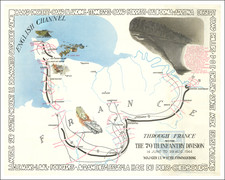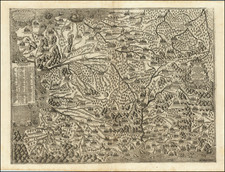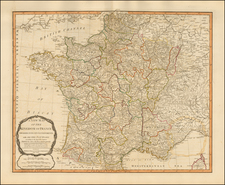Fascinating manuscript plan of Carcossone, prepared in connection with the restoration of the Citadel and town undertaken during the reign of Napoleon III, under the direction of Eugène-Emmanuel Viollet-le-Duc, one of the founders of the modern science of conservation.
The present map is a work of tremendous historical importance, reflecting the town and Citadel at the time of the commencement of Viollet-le-Duc's restoration work, which would take more than 50 years, and would ultimately be considered as a work of "profound influence on subsequent developments in conservation principles and practice." (UNESCO). Because a significant part of the restoration project included the removal of later structures which were built in and around the Citadel and its two sets of fortified walls, the present work represents a unique snapshot of Carcassonne, as it existed at the beginning of the restoration process and prior to the vast majority of Viollet-le-Duc's work at the site.
This large manuscript map of the city of Carcassone, signed by the Colonel of the City, Mr. de Rivieres Capitaine en Chef, presents a remarkable snapshot in the urban planning for Viollet-le-Duc's restoration project. The map depicts the projects planned for the years 1855 and 1856, shortly after commencment of work. The plan is signed in 1854, shortly after the restoration project was approved in 1853. ("Project des fortifications de la Cite de Carcassone durant le reigne de Napoleon III date 1854 pour les annees 1855, 1856.")
The map shows the fortified Cite at the Southeast of the map, with the inner and outer fortified walls shown with great detail. The important Basilica of Saint-Nazaire is the prominent structure labeled #20 in red, within the walls, restoration of which had already commenced by Viollet-le-Duc, as part of a separate commission. Across the river, the town Carcassonne is set out, including bridges, roads, city streets, buildings and the fortifications of the town. The key at the left shows Civil and Military Fortifications which appear in green and red, with extensive annotations shown at the lower left corner.
Carcassonne is a fortified French town in the Aude Department, in the former province of Languedoc. It is divided into the fortified Cité de Carcassonne and the more expansive lower city, the Ville Basse. Carcassone was founded by the Visigoths in the fifth century, though the Romans had fortified the settlement earlier. The fortress, which was thoroughly restored beginning in 1853 by the theorist and architect Eugène Viollet-le-Duc, was added to the UNESCO list of World Heritage Sites in 1997. The UNESCO website notes:
Carcassonne is of exceptional importance because of the lengthy restoration campaign undertaken in the latter half of the 19th century by Eugène-Emmanuel Viollet-le-Duc, one of the founders of the modern science of conservation.
The fortified city consists essentially of a concentric design with two outer walls, with towers and barbicans to prevent attack by siege engines. The castle itself possesses its own drawbridge and ditch, leading to a central keep. The walls consist of towers built over many centuries. One section is Roman and is notably different from the medieval walls with the tell-tale red brick layers and the shallow pitch terracotta tile roofs. One of these towers housed the Catholic Inquisition in the 13th Century.
Carcassonne was originally removed from the roster of official fortifications under Napoleon and the Restoration. Cité of Carcassonne fell into such disrepair that the French government decided that it should be demolished. After an official demolition decree was issued in 1849, the demolition plans met with considerable local opposition. The antiquary and mayor of Carcassonne, Jean-Pierre Cros-Mayrevieille, and the writer Prosper Mérimée, the first inspector of ancient monuments, led a campaign to preserve the fortress as an historical monument. Later in the year the architect Eugène Viollet-le-Duc, who was then restoring the Basilica of Saint-Nazaire, was commissioned to renovate the fortifications.
In 1853, work began with the west and southwest walling, followed by the towers of the Porte Narbonnaise and the principal entrance to the fortified Citadel. The fortifications were consolidated, with special attention given to restoring the roofing of the towers and the ramparts, where Viollet-le-Duc ordered the destruction of structures that had encroached against the walls, some of them of considerable age. Viollet-le-Duc left copious notes and drawings on his death in 1879, when his pupil Paul Boeswillwald, and later the architect Nodet, continued the rehabilitation of Carcassonne, until completion in 1910.
Eugène Emmanuel Viollet-le-Duc (1814 -1879) was a French architect and theorist, famous for his interpretive "restorations" of medieval buildings. Born in Paris, he was a major Gothic Revival architect, who worked primarly on the restoration of important works. He was the architect hired to design the internal structure of the Statue of Liberty, but died before the project was completed.
During the early 1830s, a popular sentiment for the restoration of medieval buildings developed in France. Viollet-le-Duc, then studying in Italy, was commissioned in 1835 by Prosper Mérimée to restore the Romanesque abbey of Vézelay. This work was the first of a long series of restorations; Viollet-le-Duc's restorations at Notre Dame de Paris brought him national attention. His other main works include Mont Saint-Michel, Carcassonne , Roquetaillade Castle and Pierrefonds. His work was strongly criticized during Viollet-le-Duc's lifetime, but is now viewed as a work of great importance, though not of the strictest authenticity.
The following is excerpted from the UNESCO website:
The historic city of Carcassonne is an excellent example of a medieval fortified town whose massive defenses were constructed on walls dating from late antiquity. It is of exceptional significance by virtue of the restoration work carried out in the second half of the 19th century by Viollet-le-Duc, which had a profound influence on subsequent developments in conservation principles and practice.
Since the pre-Roman period, a fortified settlement has existed on the hill where Carcassonne now stands. The earliest known occupation of the site dates from the 6th century BC, when a protohistoric hill fort (oppidum ) was built on this rocky spur overlooking the valley of the Aude and the ancient routes linking the Atlantic with the Mediterranean, and the Iberian peninsula with the rest of Europe. In the 1st century BC, this settlement, Carcaso Volcarum Tectosagum, became the Latin Colonia Iulia Carcaso in 27 BC. During the turbulent years of the late 3rd and early 4th centuries, it was protected by the construction of a defensive wall some 1,200 m long. The fortifications, consisting of two lines of walls and a castle, which is itself surrounded by fortifications, extend over a total length of 3 km. Their line largely follows that of the Roman defenses, and these are clearly visible over two-thirds of the total length. The Roman walls were strengthened by horseshoe-shaped bastions at roughly regular intervals. The masonry is in characteristic late Roman style: rubble cores faced with courses of dressed ashlars intersected by courses of bricks and built on concrete foundations. The Porte Narbonnaise on the eastern side and the Porte de l'Aude on the west, are particularly elaborate defensive works.
[Carcassonne] came under Visigothic rule in the 5th century and resisted repeated attempts by the Franks to capture it. The Arabs were more successful in 724, but were driven out in 759, after a siege led by Pepin the Short. The Visigothic period saw the creation of a bishopric at Carcassonne, some time in the 6th century. It is probable that a cathedral was built here, on the site of the present Romanesque cathedral, on which work began in June 1096.
The 12th-century count's castle was built over the western part of the Roman walls; it was surrounded by a rectangular fortified enclosure in 1226. By the end of the 13th century the town had assumed its definitive appearance as a medieval fortress. A local revolt in 1262 caused the king to expel most of the inhabitants. He allowed them to settle on the other side of the river, where the new town that they set up was itself fortified in 1347.
The main body of the cathedral, dedicated to St Nazaire and St Celse, consists of a central six-bayed nave with an interrupted barrel vault and two narrow side-aisles rising to almost the same height and fully vaulted. The transverse arches of the barrel vaulting spring alternately from square columns surrounded by embedded columns and round pillars. The original Romanesque choir was replaced in the later 13th century by an imposing High Gothic structure. This is a large transept with a six-sided apse at its eastern end. It is at variance with the practice in the High Gothic cathedrals of northern France, where the choir itself was stressed; accenting the transept is more in keeping with a Romanesque tradition, which here is gothicized. Its exterior, like that of most southern French Gothic churches, has no flying buttresses, stability being assured by means of the interior vaulting. It contains some important sculpture, notably the 13th-century tomb of Bishop Radulph. The stained glass in the windows of the apse and the transept is of exceptionally high quality. Three periods can be distinguished: late 13th century, early 14th century, and 16th century.
. . .
Such was the impregnability of Carcassonne that it was never attacked during the Hundred Years' War, even during the Black Prince's raid in 1355. The Huguenots made two surprise attempts to seize the town by force in 1575 and 1585, but both were quickly repressed. It became an arsenal and supply depot during the Ancien Regime and then during the Revolution. It was removed from the list of military fortresses in 1804, then reinstated as a second-grade fortress in 1820.
As a result, it was quickly treated as a convenient stone quarry and its walls and towers began to be dismantled. The survival of this magnificent set of fortifications owes its salvation to J P Cros Mayrevieille, who succeeded on July 30, 1850, in having the decree that abandoned the defenses to demolition annulled. Prosper Merimee, at that time Inspecteur General des Monuments Historiques, began discussions with the War Ministry to save the ramparts, and the first funds were made available for this purpose in 1852.
Eugene-Emmanuel Viollet-Ie-Duc, who had been commissioned to prepare a report as early as 1846, began his restoration work at the Porte Narbonnaise and the Porte de l' Aude, and continued working at Carcassonne until his death in 1879. During this time the internal fortifications were almost entirely restored, along with a number of the towers on the external defences.
In the last part of the century his successor Paul Boeswillwald removed the houses that had been constructed within the lists (the area between the two lines of walls) and continued working on the restoration of the walls and the castle. The restoration process was not completed until 1910.
An exceptional survival. While manuscript city plans of French Cities are not unusual on the market, it is quite unusual to find a manuscript artifact of an early conservation project, drawn under the direction of one of the founders of the modern science of conservation.










![[Composite Lafreri-style Atlas of Battle Plans and Fortifications]](https://storage.googleapis.com/raremaps/img/small/92702.jpg)
![[France] (2 maps - Ancient & Modern)](https://storage.googleapis.com/raremaps/img/small/70507.jpg)


![[ France ] Galliae seu Franciae Tabula, qua omnes Provinciae, Viae angiariae, et aliae res notatu dignae distincte et accurate ostenduntur . . .](https://storage.googleapis.com/raremaps/img/small/98436.jpg)